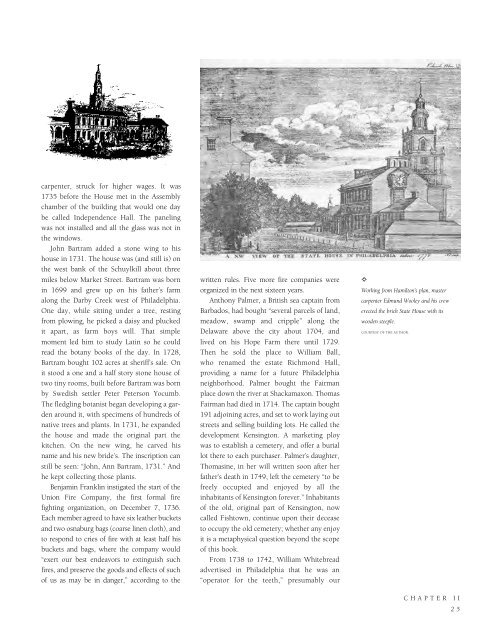Historic Philadelphia
An illustrated history of the city of Philadelphia, paired with the histories of companies, families and organizations that make the region great.
An illustrated history of the city of Philadelphia, paired with the histories of companies, families and organizations that make the region great.
You also want an ePaper? Increase the reach of your titles
YUMPU automatically turns print PDFs into web optimized ePapers that Google loves.
carpenter, struck for higher wages. It was<br />
1735 before the House met in the Assembly<br />
chamber of the building that would one day<br />
be called Independence Hall. The paneling<br />
was not installed and all the glass was not in<br />
the windows.<br />
John Bartram added a stone wing to his<br />
house in 1731. The house was (and still is) on<br />
the west bank of the Schuylkill about three<br />
miles below Market Street. Bartram was born<br />
in 1699 and grew up on his father’s farm<br />
along the Darby Creek west of <strong>Philadelphia</strong>.<br />
One day, while sitting under a tree, resting<br />
from plowing, he picked a daisy and plucked<br />
it apart, as farm boys will. That simple<br />
moment led him to study Latin so he could<br />
read the botany books of the day. In 1728,<br />
Bartram bought 102 acres at sheriff’s sale. On<br />
it stood a one and a half story stone house of<br />
two tiny rooms, built before Bartram was born<br />
by Swedish settler Peter Peterson Yocumb.<br />
The fledgling botanist began developing a garden<br />
around it, with specimens of hundreds of<br />
native trees and plants. In 1731, he expanded<br />
the house and made the original part the<br />
kitchen. On the new wing, he carved his<br />
name and his new bride’s. The inscription can<br />
still be seen: “John, Ann Bartram, 1731.” And<br />
he kept collecting those plants.<br />
Benjamin Franklin instigated the start of the<br />
Union Fire Company, the first formal fire<br />
fighting organization, on December 7, 1736.<br />
Each member agreed to have six leather buckets<br />
and two osnaburg bags (coarse linen cloth), and<br />
to respond to cries of fire with at least half his<br />
buckets and bags, where the company would<br />
“exert our best endeavors to extinguish such<br />
fires, and preserve the goods and effects of such<br />
of us as may be in danger,” according to the<br />
written rules. Five more fire companies were<br />
organized in the next sixteen years.<br />
Anthony Palmer, a British sea captain from<br />
Barbados, had bought “several parcels of land,<br />
meadow, swamp and cripple” along the<br />
Delaware above the city about 1704, and<br />
lived on his Hope Farm there until 1729.<br />
Then he sold the place to William Ball,<br />
who renamed the estate Richmond Hall,<br />
providing a name for a future <strong>Philadelphia</strong><br />
neighborhood. Palmer bought the Fairman<br />
place down the river at Shackamaxon. Thomas<br />
Fairman had died in 1714. The captain bought<br />
191 adjoining acres, and set to work laying out<br />
streets and selling building lots. He called the<br />
development Kensington. A marketing ploy<br />
was to establish a cemetery, and offer a burial<br />
lot there to each purchaser. Palmer’s daughter,<br />
Thomasine, in her will written soon after her<br />
father’s death in 1749, left the cemetery “to be<br />
freely occupied and enjoyed by all the<br />
inhabitants of Kensington forever.” Inhabitants<br />
of the old, original part of Kensington, now<br />
called Fishtown, continue upon their decease<br />
to occupy the old cemetery; whether any enjoy<br />
it is a metaphysical question beyond the scope<br />
of this book.<br />
From 1738 to 1742, William Whitebread<br />
advertised in <strong>Philadelphia</strong> that he was an<br />
“operator for the teeth,” presumably our<br />
✧<br />
Working from Hamilton’s plan, master<br />
carpenter Edmund Wooley and his crew<br />
erected the brick State House with its<br />
wooden steeple.<br />
COURTESY OF THE AUTHOR.<br />
CHAPTER II<br />
25
















